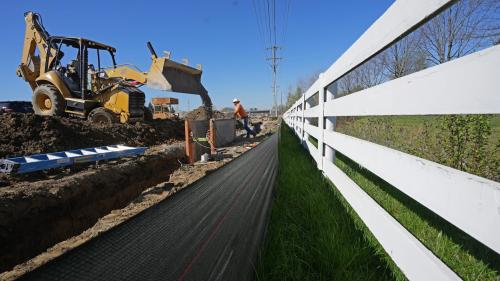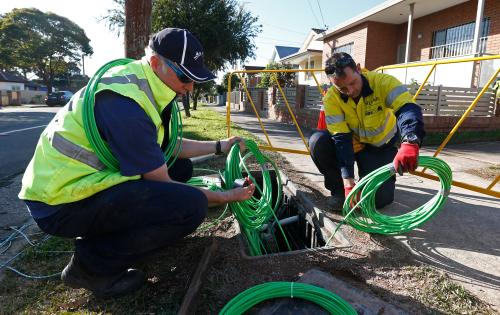The digital divide was further thrown into the spotlight after the pandemic shifted all aspects of life—from work to education to socializing—online at an unprecedented pace. During this time, the world experienced an internet spike, with 466 million people using the internet for the very first time in 2020. The number of global internet users and the percentage of internet penetration continued to grow from 2021 to 2022 at 7% and 6% respectively. While this growth indicates that progress has been made in digital access, the fact remains that as of 2022, 2.7 billion people, representing a third of the world, do not have access to the internet and 53% of the world does not have access to high-speed broadband, leading to the risk of compounding negative effects in terms of economic, political, and social inclusion and equality. These trends make it plain that policymakers should care about addressing the global digital divide, and pay attention to the continental differences that exist around technology access and use.
The data
The area of digital access and divides is a complex and multifaceted issue. Like many current complex issues, digital divides do not have a single cause or linear effect, and they involve multiple dynamic variables. Furthermore, the challenges digital divides present are constantly changing as the social and economic use of technology continues to evolve.
Looking at access to internet and mobile devices alone, there are several layers of division. The geographic location of the 2.7 billion unconnected varies greatly by region: Internet penetration is 89% in Europe, over 80% in the Americas, and 70% in the Arab States, compared to 61% in Asia and 40% in Africa. Disparities in internet connectivity and use are not limited to geographic divides, but also include gaps based on gender, age, and, rural vs. urban populations. As of 2022, there are 264 million fewer women accessing the internet than men, with women 7% less likely to own a mobile phone and 16% less likely to use mobile internet than men. Younger populations are more likely to be online as well, with 75% of global youth (aged 15-24) connected to the internet, compared to 65% of the rest of the population. In 2021, the number of internet users in urban areas was double the number in rural areas. These disparities in access to internet and mobile devices are the tip of the iceberg when it comes to the complexities and inequalities that exist within other areas of the digital divide.
To navigate this complexity, it is critical to understand that the “digital divide” does not just include the divide between those with access to the internet or mobile devices and those without, but is made up of additional overlapping divides in digital skills, digital use, quality of infrastructure, access to content, etc. The United Nations International Telecommunication Union (ITU) organizes its goals for bridging the digital divide into two buckets: universal connectivity and meaningful connectivity. The layers within these two goals can be further broken down into multiple types of access as presented in Table 1: physical, financial, socio-demographic, cognitive, institutional, political, and cultural.
| Table 1. Types of digital access | |
|---|---|
| Physical access | Physical access to devices and networks |
| Financial access | Financial access to sustain the device, infrastructure, software, maintenance, training, etc. needed to be online |
| Socio-demographic access | Socio-demographic access such as education and income level |
| Cognitive access | Cognitive access to the level of information and technological literacy needed to use digital technologies effectively |
| Institutional access | Institutional access to the internet or devices through schools, community centers, religious institutions, cybercafes, etc. versus at home |
| Political access | Political access to information and content promoted or regulated by political regimes |
| Cultural access | Cultural access to information and content relevant to specific locations and contexts |
| Source: Table created by the author, using the definitions provided by Natalia Williams, 2022. |
The complexities of digital access must be situated within the broader effects of the Fourth Industrial Revolution, as I show in my book, Africa’s Fourth Industrial Revolution, which discusses 4IR drivers and barriers across African countries. Here, I detail the risk of divides between developing and advanced economies across other factors such as gaps in research, infrastructure, and education as well as their cyclical effects: As advanced economies improve conditions for the digital economy, more 4IR investments are diverted solely to the developed world, leading developing countries to fall even further behind. This cycle is similar to the dynamics at play in other societal inequalities, in which economic incentive structures lead to value being added only for those with access. My work also shows that the digital divide is not only interstate but also intrastate—even when developing regions or countries acquire and adopt 4IR technologies, they risk exacerbating domestic inequalities due to the cost of technology and the rural-urban infrastructure divide. Reducing such intranational inequality is critical for development, as more equal countries tend to have greater political stability and resilience and are less likely to be fragile or prone to civil conflict.
A notable gap in the literature on digital divides is the relative lack of research on the broader effects of digital divides on structural transformation in developing countries specifically. Much of the research is focused on these effects (such as labor market disruptions) in developed countries, where digital technologies have historically been more concentrated. A report, “Digitalization and Digital Skills Gaps in Africa: An Empirical Profile,” addresses this lack of theoretical and empirical research on developing countries by presenting a Digitalization Index & Digital Skills Index that takes into account key factors in the digital economies of developing countries and evaluates vulnerabilities within these factors on a country-level basis. This kind of research meets a critical need, given the unique economic and labor market conditions of developing countries as well as their specific development trajectories, which do not necessarily match the experience of developed countries. More research will be needed on the digital transformation within different political economies to bridge the gap between policy and successful implementation.
Why is it so complex to fix the global digital divide and digital access gap?
Navigating the complexity of digital divides can be extremely difficult, especially given the unique circumstances and systems particular to each country, which renders one-size-fits-all policy prescriptions inadequate. However, the cross-border nature of the issue makes it one whose solutions require global consensus. As I discuss in my book, Africa’s Fourth Industrial Revolution, the 4IR is transforming all areas of economic, political, social, and diplomatic life, requiring coordinated action between governments, academic institutions, the private sector, and regional and intergovernmental bodies.
Global consensus will be critical, as the digital future cannot and should not be decided by governments or technology companies alone. As the digital divide between developed and developing countries increases and more technology companies emerge in developed countries, the power and leverage of developed countries to decide on the digital future will increase, leaving more and more of the perspectives and concerns of developing countries out of the conversation.
One prevailing challenge that may be ripe for global consensus is the lack of alignment between stakeholders such as governments, technology companies, start-ups, nonprofits, etc. on the root causes, definitions, issues, and consequences of the digital divide and the overall digital economy. Without standardization, collaboration has been difficult, as each player has a limited view of the problem. Intergovernmental bodies can play a convening role and can lead with a systems thinking approach to offer a holistic view of the problem.
Geopolitical tensions pose another challenge and potential risk, especially as technology becomes a centerpiece of power struggles, as we have seen in the rising tensions between the United States and China. Strong and broad global collaboration and consensus will be critical in order to uphold a commitment to the public good even amidst these types of tensions. Geopolitical variables will likely take on increased importance, especially as developing countries may be vulnerable to giving up digital sovereignty when it comes to infrastructure or ownership of data.
Fixing the global digital divide and digital access gap: Opportunities and existing initiatives
There have been and continue to be a wide array of approaches for mitigating and solving the issue of digital divides. Digital divide policy was previously dominated by a focus on increasing access to infrastructure, but recently it has expanded to include building digital skills, closing usage gaps, and strengthening social awareness of the internet.
Several initiatives and strategic plans from intergovernmental bodies and private companies are already in place to address these pressing issues. Each stakeholder plays a different role and brings different tools to the table. The World Bank has extensive experience working directly with countries and regions through multiple programs that leverage capacity building, technical assistance, and stakeholder connections, including the Digital Development Partnership, which offers advisory services, knowledge products, and convening services between governments, the private sector, and other stakeholders; the Digital Development Global Practice, which works directly with governments of developing countries to build the foundation for inclusive digital transformation; and other region-specific initiatives such as the Digital Economy for Africa (DE4A) initiative and the Africa Digital Moonshot Initiative, which aims to “enable digital access” to everyone in Africa by 2030.
The United Nations also has specific initiatives related to expanding access and infrastructure, such as its Broadband Commission, led by ITU and UNESCO and committed to universal connectivity; its Giga Initiative, which aims to connect every school to the internet; and UNHCR’s Innovation Service, which promotes digital access for refugees, among many others. The United Nations also plays a key role in broadening the conversation to provide a holistic picture of other factors and considerations in a global forum. For example, the UN Commission on the Status of Women is contributing to embedding gender inclusivity into all aspects of the digital economy, including by taking a deep dive into access, use, design, and monitoring of technology through the lens of gender. By making this the theme of 2023, the Commission is playing a key role in mainstreaming inclusivity into the conversation.
Meanwhile, private actors are also working on their own initiatives to solve various components of the issue—from Space X’s Starlink, which is expanding broadband to remote areas across the globe, to Google’s Next Billion Users initiative, which aims to create digital products and experiences based on user research. Such private initiatives are typically more targeted to one or two aspects of the digital divide—for example, as access to infrastructure or developing digital skills—and can be a great source of funding, particularly for resource-constrained public sectors.
The road ahead to fixing the digital divide and access gap: strategies and ways forward
While an abundance of work is being done on the topic, stronger global collaboration remains a key goal to accelerate progress and ensure these various efforts are complementing, rather than undermining, one another.
The rise of country-level and regional strategic plans is an indication of what seems to be working: addressing the digital divide by connecting it to other national challenges and goals. For example, the African Union’s Digital Transformation Strategy has been a driving force for progress on the continent by focusing on policy goals based around foundational pillars to support the digital ecosystem as illustrated in Figure 1.

Another example is the Digital India Programme, an ambitious national strategy aimed at achieving similar goals of digital infrastructure, digital empowerment, and on-demand digital governance/services that align with other economic and social goals across the country. So far, this effort has been extremely successful in connecting its citizens to services through robust investment in infrastructure and broadband, with great spillover effects, including reducing poverty from 22% in 2012 to 16% in 2019.
These strategic plans also ultimately facilitate implementation, as they are rooted in local problems, strengths, and overall contexts. Initiatives from the World Bank, UN, development banks, companies, and other players can help further accelerate progress and implementation success by partnering directly with the governments and leaders of countries and regions based on these strategies, which indicate their political willingness. These strategies can also help direct investment to the most needed areas depending on context—something best understood by country leadership itself.
Implementation and inclusivity will be key going forward. As I point out in my book, the voices of the global South, particularly youth, who will be driving the digital transformation, have been missing from these conversations. Their inclusion will be essential to overcoming digital divides in a sustainable, inclusive, and equitable way. This signals the need for greater inclusion of the voices of the global South in these discussions to steer the conversation as well as the greater inclusion of youth, who will be driving the digital transformation.
Overall, the key will be figuring out how to best embed inclusivity within every single step and variable of the digital transformation and the ever-evolving digital economy—from building infrastructure to expanding digital finance platforms to promoting entrepreneurship, and everything in between.
This article builds on Professor Landry Signé’s most recent book, Africa’s Fourth Industrial Revolution (Cambridge University Press, 2023). The article was prepared as part of New America’s Digital Futures Task Force, for which Professor Landry Signé is Working Group Lead for Digital Access and Divides.
-
Acknowledgements and disclosures
Google is an unrestricted donor to the Brookings Institution. The findings, interpretations, and conclusions in this piece are solely those of the authors and do not represent positions or policies of the Brookings Institution, its officers, employees or donors.






Commentary
Op-edFixing the global digital divide and digital access gap
July 5, 2023